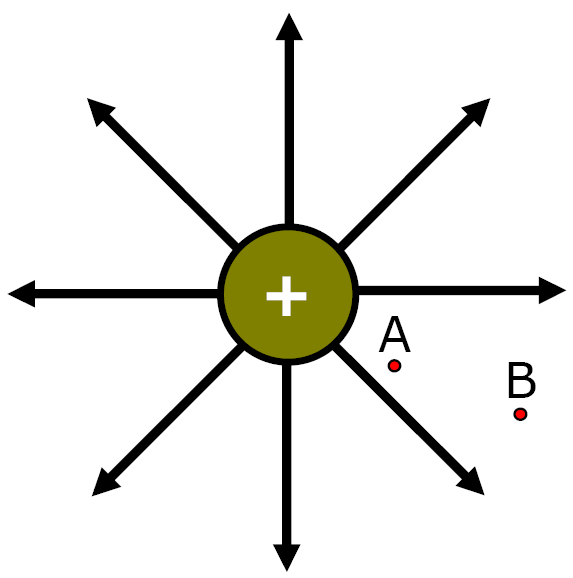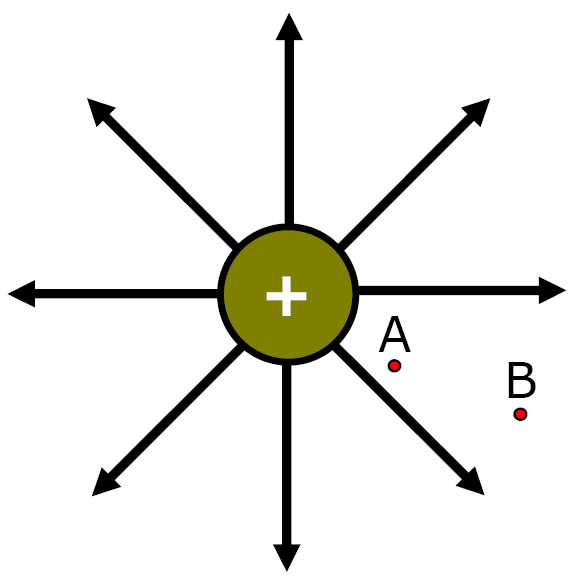![]()
![]()
Physics Fun with Gum
(Seem to need a large stick of gun to make this work.)
I.) Electric Potential - work needed or energy acquired when a positive charge is moved from infinity to a certain point in an electric field.

II) Potential Difference (Voltage) potential energy difference between 2 points in an electric field per unit of charge

A) Potential Difference, Energy & Work
As a charge moves through an electric field it gains PE or KE

If "Opposites" move
Closer

Gain KE or PE?
They Gain KE
![]()
'Opposites' Separate
Gain KE or PE?
They Gain PE
![]()
If "Likes" Separate

Gain KE or PE?
They Gain KE
![]()
If 'Likes' move...
closer
Gain KE or PE?
They Gain PE
![]()
1) Equation #1
| V = | W | (Joules) |
| q | (Coulombs) |
W = work done against field or energy acquired working with field (Joules or eV)
eV = electronVolts
(small energy unit)
q
- amount of charge moving through field (Coulombs)
V
- Potential Difference (volts)
|
Ex) It takes 6 J of work to move 2 C of charge between 2 points in an electric field. What is the potential energy difference (V) between these points? |
Ex) It takes 6 Joules of work to move 2 coulombs of charge between 2 points in an electric field. What is the potential energy difference (voltage) between these 2 points?
| V = | W | (Joules) |
| q | (Coulombs) |
| V = | 6 Joules |
| 2 Coulombs |
V = 3 Volts or J/C
2) Potential difference (V) #2
| V = | W | (eV) |
| q | (elementary charges) |
W = work done against field
or energy acquired working with field
(Electronvolts = Ev)
Electronvolt
– small energy unit
= 1.6 x 10-19 J
q - amount of charge moving through field (# elementary charges)
V - Potential Difference (volts)
|
Ex) It takes 10 eV to move 2 elementary charges from one point to another in an electric field. Find the potential difference between these points. |
Ex) It takes 10 eV to move 2 elementary charges from one point to another in an electric field. Find the potential difference between these points.
| V = | W | (eV) |
| q | (elementary charges) |
| V | = | 10 eV |
| 2 elementary charges |
V = 5 Volts
|
Ex) +2 elementary charges acquire 16 joules of energy when they move between 2 points in an electric field. What is the potential difference (voltage) between these two points in the field? |
Ex) +2 elementary charges acquire 16 joules of energy when they move between 2 points in an electric field. What is the potential difference (voltage) between these two points in the field?
Units don't match!!!
elementary charges, eV Joules/Coulombs
+2 elementary charges=
3.2 x 10-19 C
| V = | W | (Joules) |
| q | (Coulombs) |
| V = | 16 J |
| (3.2 x 10-19 C) |
Calculator Review
| Scientific Notationn TI83Plus |
V = 5.0 x 1019 Volts
or J/C
| Ex) If 4.8 x 10-17 joules of work is required to move an electron between 2 points in an electric field, what is the electric potential difference between these points? |
|
|
|
| a) 3.0 x 102 V | b) 4.8 x 10-17 V |
| c) 1.6 x 10-19 V | d) 4.8 x 102 V |
|
Ex) If
4.8 x 10-17
joule of work
is required to move an
electron between 2 points in an
electric field, what is the electric
potential difference between these points? |
|
|
|
|
| a) 3.0 x 102 V | b) 4.8 x 10-17 V |
| c) 1.6 x 10-19 V | d) 4.8 x 102 V |
W = 4.8 x 10-17 Joule
V = ?
q = ?
Hint: The charge in this problem is an electron
q = 1.6 x 10-19
C
| V = | W | (Joules) |
| q | (Coulombs) |
V = 4.8 x 10-17 J / (1.6 x 10-19)C
a) 3.0 x 102 V
![]()
![]()
© Tony Mangiacapre., - All Rights Reserved [Home] Established 1995
Use any material on this site (w/ attribution)
